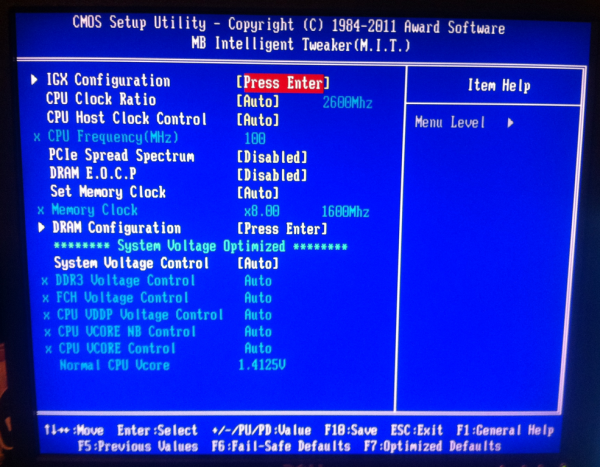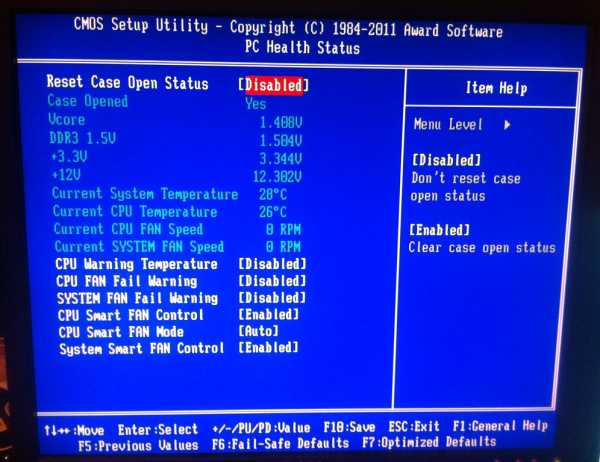Gigabyte GA-A55M-S2V Review
by Brendan van Varik on March 21, 2012 9:00 PM EST- Posted in
- Motherboards
- Gigabyte
- Llano
- A55
BIOS
Upon first glance, you will instantly notice that Gigabyte has not used a graphical based BIOS for this motherboard. This is perhaps due to Gigabyte’s late entry into the graphical arena for BIOSes, but the feel of the BIOS could be considered somewhat backdated compared to most motherboards today. Nevertheless, it is built on the functionality and ease of use of the past ten-plus years, so it should work.
First thing to note is the front screen, which due to the old-style nature, does not have any of the information we would generally want the minute we enter the BIOS. We would like to see, inter alia, what CPU is in the board, what speed it is running at, how much memory is in the system (and how fast it is running), CPU temps, voltages, and fan speeds. For any of this information, the user has to delve into the MB Intelligent Tweaker or PC Health Status options from the front menu.
The overclocking options are located under the MB Intelligent Tweaker (M.I.T) section. Within this submenu you can change everything to do with the system clocks, memory ratios and voltages. The IGX (integrated graphics) configuration is where you can tweak the onboard GPU of the Llano APUs (even if the GPU is locked – the options will actually just do nothing) and the rest within this menu is fairly self-explanatory. The one gripe I have with this BIOS is the voltage options. It does not give you the voltage which you are setting but instead it uses the offset (+/-0.0125 V) style. It is not an issue with the BIOS but more a personal preference.
The fan settings are located under the PC Health Status menu. There are not very many options for the fan settings at all. When it comes down to you wanting to choose whether you would like the system fans to be on the SMART fan option, there are only two options to choose from and they consist of ‘Enabled’ or ‘Disabled’. Just like the CPU fan, the system fans, which when set to enabled, will slow the fans down when the system is in idle and they will subsequently speed up when the system starts to warm up. The CPU fan controls are very limited as well. You can choose from either a voltage for the fan to run at or you can choose the PWM feature. In our case when the motherboard was tested, auto was used.
There are no noticeable changes between the F2 BIOS which was first installed on this motherboard compared to the F6 BIOS which was installed and used for our testing. It was easily updated via a USB stick (FAT32 formatted) by using Q-Flash, which can be started by pressing F8 whilst in the BIOS. The only major changes to the BIOS would involve the CPU compatibility codes and possible improvements to the system stability.
Overclocking
For the Gigabyte GA-A55M-S2V and the BIOS system, there are no automatic overclocking features available. As a result, users will have to perform manual overclocks to increase performance – I will reiterate that the VRM solution on this board isn’t designed to dissipate heat as much as the A75 boards we’ve tested, and your mileage may vary.
I dived straight into the deep end. Due to overclocks with this particular processor being successful on other motherboards, I started off with a 125 MHz bus which is a 25% overclock and it booted straight into Windows without any issues. These overclocks were achieved using the auto settings for the voltages. I continued to push higher until the motherboard would no longer boot up and I eventually ended up on a final clock speed of 3640 MHz. This was achieved using a 140 MHz bus speed with 1.5 V on the CPU, whilst keeping the RAM as close to 1333 MHz as possible by adjusting the straps as I went along to ensure that the RAM was not holding the overclock back. This gave a fully stable Blender test.



















21 Comments
View All Comments
seanleeforever - Thursday, March 22, 2012 - link
why not just purchase some DC power supply and take the read out directly? what the system will suck out of the socket can be computed by the efficiency of your PSU at that particular load. (say the system uses 100W, and you know your PSU has 80% efficiency at 100W, then you can compute that you system will suck out 120W from the wall)speaking of which, when will anandtech actually buy some product for testing instead of taking what manufacture 'supplied' parts? because we all know there is absolutely no any conflict of interest when a manufacture 'send' you their 'regular' product for 'free' for this website to write an great review to 'speak truth' about their product.
Shadowmaster625 - Thursday, March 22, 2012 - link
Actually a 5850 is a smart choice. Maybe not this particular version, but a generic 5850. One might find such a beast for under $100 on ebay at some point in the next 6 months. That would be a great deal for a value gamer.Ratman6161 - Thursday, March 22, 2012 - link
I'm in the process of decision making for a low cost, small form factor system for my wife to use. I'm comparing Intel i3 Vs Llano and finding I can get an i3 2125 or a AMD A8 38xx for about the same price and to me it comes down to graphics performance. My take:1. If you want to get the best processing power, go with i3
2. If you want the best graphics you can get without the need for a pci-e card, and processing power is not that important to you get llano.
3. If you want processing power and better graphics too, get i3 with a pci-e card
4. If you want better graphics than Llano offers, once again its i3 with pci-e card
So the only scenario (at least for me) where AMD makes sense is #2 which actually happens to be what we are looking for. Testing it with an add on card doesn't help me. And if you wanted to use AMD with an add on card, you could just go with a cheap Athlon X4 - as you wouldn't need the graphics on the Llano cpu anyway.
loimlo - Saturday, March 24, 2012 - link
Yes, I'd like to see power consumption figures without a discrete VGA. I'm fine with 5850 given it's a requirement of formula across motherboard reviews, but something like integrated VGA would be welcomed.Btw, does Anandtech consider using smaller PSU in the future review? It seems ridiculous to use 1250W for such an entry-level product. It's unrealistic for mass deployment and inefficient at such low load.
ssj3gohan - Thursday, March 22, 2012 - link
It's good to see other people complaining about this, too. Power consumption is, especially compared to the high quality of their other reviews and articles, an underdeveloped appendage at Anandtech.ssj3gohan - Thursday, March 22, 2012 - link
A lot of sentences and general flow of this article are in my opinion sub-par for a site like AnandTech. It seems like this article was first written in Dutch and then translated straight up sentence-by-sentence into English. It would really help readability if the article were edited by a native speaker.silverblue - Thursday, March 22, 2012 - link
You may wish to provide examples as I don't see what you're referring to. In my eyes, it's a very comprehensible article and I haven't had to read something twice to decipher what the author is trying to get across.Taft12 - Thursday, March 22, 2012 - link
I felt the same way as ssj3gohan when I read the article, here's 3 awkward sentences in a row:"The blue PCB which the GA-A55M-S2V is built on is a typical sighting from the current Gigabyte budget segment. Keen eyes will notice the lack of VRM heatsinks, despite this board being certified to run 100W processors. This will undoubtledly lead to little room in terms of pushing the platform."
Don't get me wrong however, this is a good review and bravo to Anandtech for reviewing more entry-level components. Just peer-review them before putting it live.
ggathagan - Thursday, March 22, 2012 - link
There's absolutely nothing wrong with any of those sentences.The closest to "awkward" one could get would be the use of "a typical sighting".
Even that, however, is a somewhat common turn of phrase.
If I wrote tech reviews for a popular website, I would get very tired of writing essentially the same thing over and over again.
In that circumstance, I would certainly try to inject a little variety by doing exactly what Brendan appears to have done.
silverblue - Friday, March 23, 2012 - link
The only thing I could recommend here is adding a small amount of punctuation, but that's it. For example:"The blue PCB - which the GA-A55M-S2V is built on - is a typical sighting from the current Gigabyte budget segment."